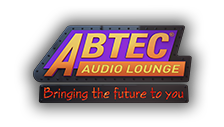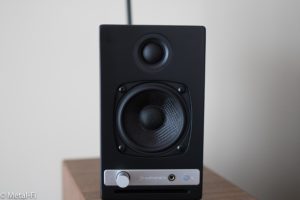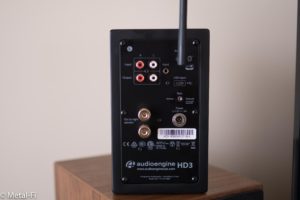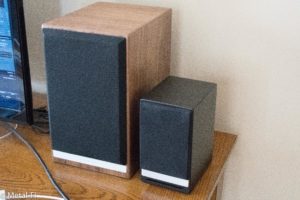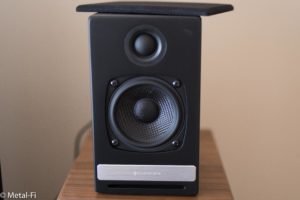Introduction
One of the very first pieces of audio gear that I wanted to upgrade when I was a wee lad were my computer speakers. My first set came with a Dell desktop system my parents bought me when I was a senior in high school to prepare for college. They were small, rectangular, and sounded terrible – zero bass or treble to speak of with a really muddy midrange. And I loved them.
When they finally died I decided to up my game by buying a complete 5.1 surround system made by Sound Blaster. I don’t remember the exact model but the two front satellites were actually bigger than my Dell’s, with the center channel placed on top of my monitor and the rears on plastic stands that you would place behind you. The subwoofer was of course sitting in the proverbial corner. Room correction be damned, Quake never sounded so good.
And I’ll bet for many of you, especially for those of you who grew up in the ’90s, computer speakers are your main playback system of choice. Recently, I upgraded my system to a pair of Audioengine HD6s ($749), which as my review concluded, pack a lot of sonic punch for the dollar. However, AE has just introduced the HD3s ($399), a smaller and more affordable version of the six aimed squarely at the desktop market. But do the threes being almost half the price of the sixes also mean half the fun? Time to dust off my old Quake CD and find out.
The Little Engine That Could
Most audiophile’s know of AE because of their well regarded A series of speakers – first with the A5 and now with the A2 and A2+. And the A series embodies the Audioengine mantra perfectly: affordable hi-fi sound in a well-thought out package. Moreover, I’ll bet dollars to donuts that the A series have been responsible for creating more audiophiles than any other computer speaker on the market today. So in many respects, the HD3s are a lot like the A2+ both in spirit and design. In fact both share the same passive crossovers, kevlar drivers, and power supply, and both offer up to 60Ws of peak power. They are also about the same size too.
But unlike the A2+, the HD3s come with both a D1 and B1 included just like in the HD6s. So that means extended range Bluetooth connectivity via aptX, a built-in AKM4396 DAC, as well as a real honest-to-goodness headphone amplifier based around the TI OPA2134 op-amp. So if you are in the market for a pair of speakers but also wouldn’t mine upgrading your headphone experience too, the HD3s present themselves as a really attractive all-in-one solution. Particularly if your significant other isn’t always into YouTubing the latest brutal tech death release as much as you are. Trust me on this.
I stuck a pair of Audeze SINE headphones into its 3.5mm jack and let it rip for a while. Is it as good as say my iFi micro iDSD or Chord Mojo? Not on your life. Is it significantly better than the output on my 2016 MBP. You betcha. Again, provided you don’t have some really hard to drive headphones, the HD3s’ amplifier gets the job done and then some. Try it.
Blue In The Tooth
So the HD series is designed around two guiding principles: connectivity and a more refined sound than its A series counterparts. Regarding the first principle, the HD3s give you loads of options. There is of course the standard speaker terminals as well as a pair of RCA inputs and outputs. There is also a stereo mini-jack input as well as USB in just in case you want to light up that AKM. I’m going to go out on a limb and say that if you can’t build a system around the HD3s then maybe this hobby isn’t really for you. Seriously.
But the threes’ real claim to fame is its extended range Bluetooth connectivity, with aptX and AAC support. My HD6 review already went through why aptX is a “big deal” from a purely sonic perspective. But even outside of that, I can’t underscore enough just how versatile the HD3s are because they can be deployed wirelessly. I’ve used my review samples in the living room, on my desk, in the kitchen, you name it. There is really no place the HD3s don’t feel right at home provided you have a power outlet, Spotify, and a smart phone [Dave: An audiophile’s worst nightmare!].
And when AE says extended, they mean it. Again, just like with the HD6s, the Bluetooth range on the HD3s are outstanding. I had no drop outs to really speak of walking around my house doing chores. I have an open layout home which probably helps to a certain extent, but I suspect unless you live in a castle, your experience should be very similar to mine.
Fit & Finish
As you can also tell from the pics, a lot of its fit and finish takes design cues from the HD6s, with the same semi-retro styling with detachable magnetic grills. And like the HD6s, you have a choice of cherry, walnut, and a clean satin black finish. I generally prefer wood but the Satin Black samples I received are quite handsome too. My only gripe is that the black finish tends to leave a lot of fingerprints.
However, unlike the HD6s you don’t get a remote, which I did find to be a somewhat minor annoyance. Though the threes do feel very comfortable in a desktop environment where the volume knob is always at arm’s length, I still think AE should have included one nevertheless. Not a deal breaker but something to keep in mind when you are ready to deploy at your next toga party.
Refined Not Rowdy
One of the biggest complaints that the A2 has is it tends to have a somewhat muddy midrange. Part of the problem is that AE was trying to create an “all-arounder” with the A2, sacrificing clarity to eek out a more robust low-end despite its small stature. To mitigate this issue with the HD3s, AE has included a bass switch that will limit its low-end frequency response to 100Hz instead of its fully spec’ed out 65Hz. The idea is that if you have a subwoofer, or just want a more refined sound, you can choose to limit the bass response in favor of a cleaner midrange. I opted to switch the “Bass Reduced” button back and forth during my review to get a sense of what it was adding (or removing) from the music. I’ll note the changes below. Finally, most of my listening was done via Bluetooth using aptX since I feel it is one of the main selling points of the HD series in general.
Blind Guardian is the greatest power metal band of all-time and 1995’s Imaginations from the Other Side is their magnum opus. This my friend is gospel. And the track “Bright Eyes” is still to this day one of my all-time favorites. It is the song that got me into these Hobbit loving Germans in the first place, and the HD3s certainly do it justice. In bass reduced mode the speakers sound a bit thin in the low-end but very peppy in the mids. I definitely agree with AE that with the bass turned down the HD3s sound “cleaner” and even image a tad better too. Instrumentation separation especially improves when you ditch the last 35Hz and let the threes just do their thing. With that said, I think the track sounds more “true” to BG’svision in normal mode since this is an older recording and the bass is mixed fairly well.
Love’em or hate’em, there is no question that Jari Mäenpää of Wintersunhas an incredible passion for music (certainly his anyway). He is currently in the process of not one but three separate fundraising campaigns in order to build a studio to finish his Time and recently announced Forest projects. And though Time I could not possibly live up to the hype surrounding it, it was still a beautiful record nevertheless. The first two tracks, “When Time Fades Away,” which serves as the preamble to “Sons of Winter and Stars”, pretty much goes through the full gamut of what Jari and Co. are all about. I spent a lot of time with these tracks going back and forth between the HD6s and HD3s (in normal bass mode) and I got to tell you, the HD3s are a blast! No, the they don’t outclass their bigger sibling by any stretch of the imagination, with the sixes offering up a more robust stereo image and obviously better lows and highs. But the HD3s are crystal clear where it counts (hint: the mids), especially for its size. Jari’s vocals sound fantastic on the three, as do most of the synth and guitar work layered throughout. I found myself turning the volume higher and higher too as the HD3s are not shy about their 60 watts of power they belt out. On a personal note: My wife did stop me during this review due to my overzealous use of the volume knob. A really good sign.
Gorod are probably the catchiest tech death metal band in existence, and my personal favorite of theirs is 2009’s Process of a New Decline. It’s also a somewhat dynamic record too, particularly for tech death, clocking in at a healthy DR7. Again, the HD3s sound very lively, particularly if you keep it in bass reduced mode. One thing that became crystal clear though as I listened to this record all the way through was just how good they image for such tiny speakers. I can clearly make out exactly how Process was mixed, with the drums and vocals centered and guitars off to the sides. I wound up playing with their placement on my desk and it really didn’t make that much of a difference provided I gave them some reasonable directionality toward my ears. Though you could fill up a small room with them, I still prefer the HD3s as near-field monitors. Regardless, I believe unless your desktop environment is a bit unorthodox, the HD3s will image wonderfully without too much of a fuss.
Final Thoughts
As a complete package, it’s hard to argue with the HD3s. They sound great for their size and if you want more oomph in the low-end then all you have to do is pick up a sub (AE’s S8 for instance would fit the bill nicely). My only reservation is their price. They’re $399 which is a lot for a pair of small desktop speakers, particularly when you have a lot of options to choose from. For example, you could opt for a pair Emotiva Airmotiv B1’s ($299), or even cheaper the Adam Audio F5s ($229). Both of which will probably give you sound on par with the HD3s. But then you need an amp, a DAC, and a lot of other paraphernalia too. The fact is the HD3s are really an entire stereo system than just a pair of computer speakers. And when you look at it from that perspective they offer an incredible value for their asking price. In fact, if you are starting from ground zero, I can think of no better all-in-one on the market today at this price point. Once again, Quake never sounded so good.
Read more at:
Where to buy Audioengine HD3: https://www.abtec.co.nz/Audioengine_HD3_
